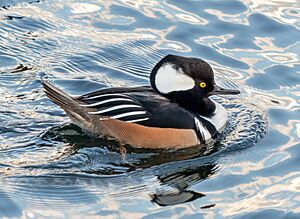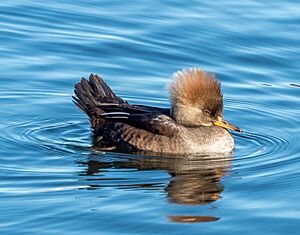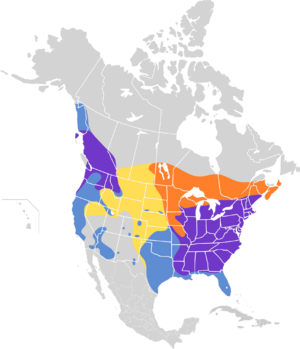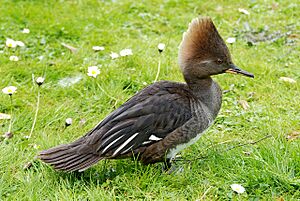Hooded merganser facts for kids
Quick facts for kids Hooded merganser |
|
|---|---|
 |
|
| Male | |
 |
|
| Female | |
| Conservation status | |
| Scientific classification | |
| Genus: |
Lophodytes
|
| Species: |
cucullatus
|
 |
|
| Breeding Migration Year-round Nonbreeding | |
| Synonyms | |
|
|
The hooded merganser (Lophodytes cucullatus) is a cool duck that eats fish. It's the only living species in its group, called Lophodytes. This name comes from Greek words meaning 'crest' and 'diver'. Both male and female hooded mergansers have a special crest on their heads. They can raise or lower this crest. The male's feathers are very colorful during breeding season. These ducks have a sawbill, which is a beak with jagged edges.
Hooded mergansers are the second-smallest type of merganser duck. Only the smew from Europe and Asia is smaller. The hooded merganser is the only merganser duck that lives only in North America.
Contents
About the Hooded Merganser
The famous scientist Carl Linnaeus first described the hooded merganser in 1758. He gave it the scientific name Mergus cucullatus.
What Does a Hooded Merganser Look Like?
Male and female hooded mergansers look different. This is called sexual dimorphism.
- The adult female has a grey-brown body.
- She has a white patch on her lower chest and belly.
- Her crest is light reddish-brown.
- Female hooded mergansers have brown eyes.
During the non-breeding season, the male looks a lot like the female. But his eyes are yellow, which helps tell them apart.
When it's time to breed, the male's feathers change.
- His head, neck, and chest become mostly black with white marks.
- He has large white patches on his crest. These patches are easy to see when he raises his crest to attract a mate.
- His lower sides are a rich reddish-brown color.
- His chest and belly are mostly white.
Both male and female birds have thin white stripes on their wing feathers. When the bird is resting, these stripes can look like white lines on its lower back.
Young hooded mergansers look a bit different from adult females.
- Their necks and upper parts are grey-brown. Adult females have much darker, almost black, upper parts.
- Young birds have thinner white edges on their wing feathers than adults.
- Female birds of all ages have dark eyes. But young males' eyes turn pale during their first winter.
Measurements:
- Length: 15.8 to 19.3 inches (40 to 49 cm)
- Weight: 16.0 to 31.0 ounces (453 to 879 grams)
- Wingspan: 23.6 to 26.0 inches (60 to 66 cm)
Where Do Hooded Mergansers Live?
Hooded mergansers are migratory birds. They travel shorter distances than some other birds. They spend winters in parts of the United States where water stays unfrozen.
They have two main areas where they live all year round:
- One area is in the eastern United States. It stretches from the border with Canada down the Atlantic Coast to the Gulf Coast.
- A smaller area is in Washington state and southern British Columbia. It also reaches into northern Idaho.
They also breed in other areas, like from Missouri to southern Canada. They can be found from Nova Scotia to eastern North Dakota and Saskatchewan. They move from these places when winter weather makes it too cold. The number of hooded mergansers has been growing since 1966.
Hooded mergansers like to live on small bodies of water. This includes ponds and small rivers where there are many plants growing in the water. They also live in larger wetlands, flooded forests, and rivers. They prefer fresh water, but they can also live in slightly salty water.
Hooded Mergansers in Europe
Hooded mergansers are often kept in zoos or private collections in Europe. Most birds seen in the wild there are thought to have escaped. However, a few have been seen that are believed to be truly wild vagrants. The first accepted wild sighting in Britain was in October 2000. Some are seen regularly in Dublin, but these are likely escaped birds.
What Do Hooded Mergansers Eat?
The hooded merganser is a diving bird that hunts underwater. It mostly uses its eyesight to find food. Its diet changes depending on what's available.
- Most of its diet (44% to 81%) is fish.
- It also eats aquatic insects (13% to 20%).
- Other water creatures like crabs and crayfish make up 22% to 50% of its diet.
Hooded Merganser Reproduction and Life Cycle
Male and female hooded mergansers form pairs for breeding. They stay together until the female finds a nesting spot and lays all her eggs. After that, the male leaves the female. She then takes care of the eggs and young birds by herself.
Females look for holes in dead trees to build their nests. They also use artificial nest boxes, like those made for wood ducks. They prefer holes that are 4 to 15 feet off the ground. Breeding can happen from late February to late June, depending on the area.
The female lays between 7 and 15 eggs. She only starts sitting on the eggs when the last one is laid. This means all the ducklings hatch at about the same time. This helps the mother take care of them more easily. While she is sitting on the eggs, the female can lose 8% to 16% of her body weight.
Like most waterfowl, hooded merganser ducklings are precocial. This means they are quite developed when they hatch. They usually leave the nest within 24 hours after hatching. This is just enough time for all the ducklings to hatch. Once they leave the nest, the young can dive and find food on their own. But they stay with their mother for warmth and protection.
Protecting Hooded Mergansers
In the past, the number of hooded mergansers went down. This was because many forests were cut down. These ducks need holes in old trees to make their nests. So, they need mature trees to find good nesting spots.
Today, managing forests carefully is helping to increase their habitat. A key part of protecting these ducks is making sure there are enough old trees with nesting holes. These ducks also use man-made nest boxes if they are available.
Hooded mergansers rely a lot on eating water creatures. This means they are easily harmed by pollution. Some pollution can poison the animals they eat. This then poisons the ducks higher up in the food chain. Other types of pollution simply reduce the number of animals they can eat.
See also




